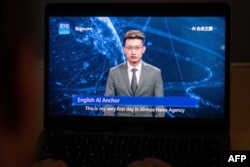China’s state-run Xinhua News has debuted what it called the world’s first artificial intelligence (AI) anchor. But the novelty has generated more dislikes than likes online among Chinese netizens, with many calling the new virtual host “a news-reading device without a soul.”
Analysts say the latest creation has showcased China’s short-term progress in voice recognition, text mining and semantic analysis, but challenges remain ahead for its long-term ambition of becoming an AI superpower by 2030.
Nonhuman anchors
Collaborating with Chinese search engine Sogou, Xinhua introduced two AI anchors, one for English broadcasts and the other for Chinese, both of which are based on images of the agency’s real newscasters, Zhang Zhao and Qiu Hao respectively.
In its inaugural broadcast last week, the English-speaking anchor was more tech cheerleader than newshound, rattling off lines few anchors would be caught dead reading, such as: “the development of the media industry calls for continuous innovation and deep integration with the international advanced technologies.”
It also promised “to work tirelessly to keep you [audience] informed as texts will be typed into my system uninterrupted” 24/7 across multiple platforms simultaneously if necessary, according to the news agency.
No soul
Local audiences appear to be unimpressed, critiquing the news bots’ not so human touch and synthesized voices.
On Weibo, China’s Twitterlike microblogging platform, more than one user wrote that such anchors have “no soul,” in response to Xinhua’s announcement. And one user joked: “what if we have an AI [country] leader?” while another questioned what it stands for in terms of journalistic values by saying “What a nutcase. Fake news is on every day.”
Others pondered the implication AI news bots might have on employment and workers.
“It all comes down to production costs, which will determine if [we] lose jobs,” one Weibo user wrote. Some argued that only low-end labor-intensive jobs will be easily replaced by intelligent robots while others gloated about the possibility of employers utilizing an army of low-cost robots to make a fortune.
A simple use case
Industry experts said the digital anchor system is based on images of real people and possibly animated parts of their mouths and faces, with machine-learning technology recreating humanlike speech patterns and facial movements. It then uses a synthesized voice for the delivery of the news broadcast.
The creation showcases China’s progress in voice recognition, text mining and semantic analysis, all of which is covered by natural language processing, according to Liu Chien-chih, secretary-general of Asia IoT Alliance (AIOTA).
But that’s just one of many aspects of AI technologies, he wrote in an email to VOA.
Given the pace of experimental AI adoption by Chinese businesses, more user scenarios or designs of user interface can be anticipated in China, Liu added.
Chris Dong, director of China research at the market intelligence firm IDC, agreed the digital anchor is as simple as what he calls a “use case” for AI-powered services to attract commercials and audiences.
He said, in an email to VOA, that China has fast-tracked its big data advantage around consumers or internet of things (IoT) infrastructure to add commercial value.
Artificial Intelligence has also allowed China to accelerate its digital transformation across various industries or value chains, which are made smarter and more efficient, Dong added.
Far from a threat to the US
But both said China is far from a threat to challenge U.S. leadership on AI given its lack of an open market and respect for intellectual property rights (IPRs) as well as its lagging innovative competency on core AI technologies.
Earlier, Lee Kai-fu, a well-known venture capitalist who led Google before it pulled out of China, was quoted by news website Tech Crunch as saying that the United States may have created Artificial Intelligence, but China is taking the ball and running with it when it comes to one of the world’s most pivotal technology innovations.
Lee summed up four major drivers behind his observation that China is beating the United States in AI: abundant data, hungry entrepreneurs, growing AI expertise and massive government support and funding.
Beijing has set a goal to become an AI superpower by 2030, and to turn the sector into a $150 billion industry.
Yet, IDC’s Dong cast doubts on AI’s adoption rate and effectiveness in China’s traditional sectors. Some, such as the manufacturing sector, is worsening, he said.
He said China’s “state capitalism may have its short-term efficiency and gain, but over the longer-term, it is the open market that is fundamental to building an effective innovation ecosystem.”
The analyst urges China to open up and include multinational software and services to contribute to its digital economic transformation.
“China’s ‘Made-in-China 2025’ should go back to the original flavor … no longer Made and Controlled by Chinese, but more [of] an Open Platform of Made-in-China that both local and foreign players have a level-playing field,” he said.
In addition to a significant gap in core technologies, China’s failure to uphold IPRs will go against its future development of AI software, “which is often sold many-fold in the U.S. than in China as the Chinese tend to think intangible assets are free,” AIOTA’s Liu said.









